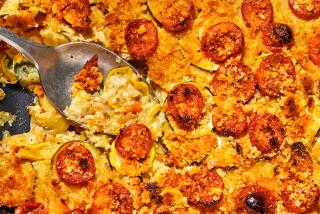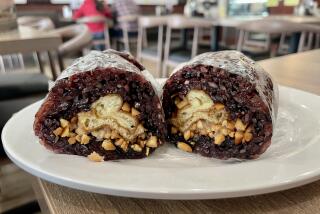Turn up the heat, and endive follows
- Share via
SOME say “Belgian endive,” others say “endive” and yet others say “chicory.”
In 1984, the late Jennifer Paterson, best known as one of BBC television’s “Two Fat Ladies,” tried to clear up the confusion over the bomb-shaped little vegetables. After an agreeably boozy lunch in London sponsored by the Dutch endive growers, she dedicated a column to it in the Spectator magazine. Belgian endive’s “real, glorious name,” she said, was “witloof, like a character from one of Wagner’s operas.”
“If everybody would call it witloof,” she concluded, “there wouldn’t be any trouble.”
Everybody didn’t, and confusion remains between the tightly furled little rockets called Belgian endive and the big frilly salad leaves, also known as endive.
Perhaps we lack the resolve to get the name straight because we use Belgian endive so sparingly. These strangely pale shoots are hothouse vegetables, forced in heated greenhouses from transplanted chicory roots. Farmers here and in the Netherlands take such elaborate measures to grow them for winter tables that they are a notable luxury, often costing from $4 to $5 a pound.
Are they worth it? Raw, they’re crunchy, bland at first, but then carrying a pleasingly bitter edge. A few will perk up a salad. It’s a certain show of sophistication, if not one packing much pleasure.
But where they come into their own, and become an item worth crossing town for, is when you cook them. Only heat coaxes out a unique and arresting spectrum of flavors that runs from sharp and earthy to meltingly sweet.
Sauteed, baked, braised or grilled, Belgian endive make sense of dishes that often don’t quite work with American produce. For instance, Marcella Hazan recommends Belgian endive as a substitute for radicchio when we can’t find the mild Treviso variety traditional in Italian cooking. The substitution saves dishes because American radicchio can be too tough for grilling or light sauteing.
It can stand in for radicchio in a number of ways: sweated in the bacon pan, then stirred into risotto or spaghetti carbonara, or melted in butter made into another pasta sauce, this time with melted Gorgonzola and walnuts.
To my mind, there are two ways to cook Belgian endive: slow or slower.
The first recipe here is adapted from a Hazan radicchio recipe. This produces a rich, earthy side dish that can be served right from the oven, or cold, or maybe best of all, the next day after its flavors have intensified. Its bitter edge makes it a particularly good side dish for veal.
The second dish involves a long, dreamy afternoon in the kitchen. It’s an adaptation of a Julia Child recipe for Belgian endive braised in butter that, after an hour and a half of cooking, is so rich as to constitute a dish in itself.
But I couldn’t help turning up the luxury. Take these golden braised endives, wrap them in prosciutto, set them in a Parmesan-laced bechamel and broil. Invite over some people you love, and open a bottle of Pinot Gris. This isn’t dinner. This is bliss.
Paterson and Child both recommend variations of this treatment, using ham. The choice of prosciutto was mine.
One can, and should, I find, gild the witloof.
*
Baked endive
Total time: 45 minutes
Servings: 6
Note: This recipe is from “The Essentials of Classic Italian Cooking” by Marcella Hazan (Knopf, 1992).
12 heads Belgian endive (about 2 1/4 pounds)
Salt
Freshly ground pepper
6 tablespoons extra-virgin olive oil
1. Heat the oven to 400 degrees.
2. Trim then cut the endive in half lengthwise; wash and shake dry. Place the endive halves, cut side down in a jellyroll pan. Add salt and pepper to taste and the oil, distributing it evenly.
3. Bake the endive 10 minutes and turn, then bake it another 6 to 7 minutes and turn again. Cook it until its base feels tender when prodded with a fork, about 20 minutes longer. Allow it to settle a few minutes before serving. It is also good at room temperature.
Each serving: 126 calories; 230 mg. sodium; 0 cholesterol; 12 grams fat; 2 grams saturated fat; 5 grams carbohydrates; 2 grams protein; 4.79 grams fiber.
*
Endive and prosciutto gratin
Total time: 2 hours
Servings: 6
Note: This is adapted from Julia Child’s recipe for braised Belgian endive in “Mastering the Art of French Cooking” (Knopf, 1961).
Endive
12 firm heads Belgian endive
5 tablespoons butter, divided
1/4 teaspoon salt
Juice of 1/2 small lemon, or 1 tablespoon
1/4 cup water
1. Heat the oven to 400 degrees.
2. Trim the bottoms of the endives and discard. Wash the whole endives under running water and shake dry. Cut the endives in half lengthwise. Smear 1 1/2 tablespoons of butter in a 9-by-13-inch stove-to-oven casserole. Lay the endives in it so they cover the bottom. Sprinkle with some of the salt and half the lemon juice. Make another layer of endives, and add more salt and lemon juice. Add the water. Cut the remaining butter into small pieces and dot the top of the endives. Cover and simmer over medium heat for 10 minutes. Uncover and boil rapidly until the liquid is reduced to 2 or 3 tablespoons, for about another 10 minutes.
3. Place a sheet of buttered wax paper over the pan, cover with a lid and place in the oven. Reduce the heat to 325 degrees. Bake for 1 hour. Remove the casserole cover but leave the wax paper and bake until the endives are golden, about 20 to 30 minutes
Cheese sauce
2 tablespoons butter
3 tablespoons flour
2 cups milk
1/4 teaspoon salt
Freshly grated nutmeg
1 ounce finely grated Parmigiano-Reggiano
2 ounces medium-grated Swiss cheese
1. Melt the butter in a heavy-bottomed, medium-sized saucepan over medium heat, then stir in the flour until smooth. Cook 2 to 3 minutes to get rid of the raw flour taste. Remove from the heat and set aside.
2. Bring 2 cups of milk to boil in a small saucepan and add the grated nutmeg, about 11 passes on the grater. Whisk the heated milk into the roux, followed by the Parmigiano-Reggiano and Swiss cheeses. As it thickens, cover and set aside.
Assembly
12 slices prosciutto, trimmed of fat edges (about 1/3 pound)
3 tablespoons grated Swiss cheese
1 tablespoon butter, cubed
1. Heat the broiler and set a rack in the middle of the oven.
2. Butter a shallow 2-quart baking dish. Add half of the cheese sauce.
3. Lay the prosciutto slices on a work surface. Add 2 endive halves to a prosciutto slice, then roll the slice up over the endives to form a bundle. Repeat with the remaining endive halves and prosciutto slices. Neatly arrange the 12 prosciutto-endive wraps in the baking dish.
4. Cover the wraps with the remaining cheese sauce. Sprinkle with the Swiss cheese and dot with the butter. Set the dish in the oven and broil until bubbling and the cheese has browned a bit, 3 to 4 minutes. You’ll want to do this just before you serve dinner so that the dish is nice and hot.
Each serving: 340 calories; 815 mg. sodium; 81 mg. cholesterol; 27 grams fat; 15 grams saturated fat; 12 grams carbohydrates; 14 grams protein; 3.65 grams fiber.
More to Read
Eat your way across L.A.
Get our weekly Tasting Notes newsletter for reviews, news and more.
You may occasionally receive promotional content from the Los Angeles Times.









